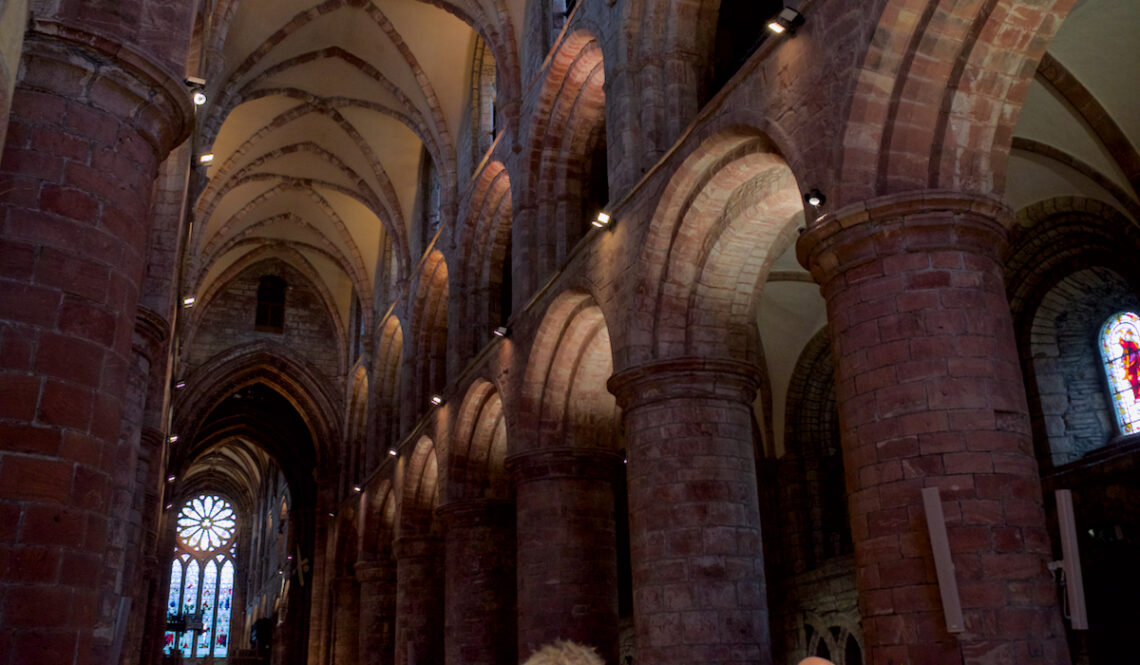
Orkney: St Magnus’ Cathedral, Kirkwall
The red sandstone tower of St Magnus’ Cathedral, topped with a conical steeple, rises head and shoulders above the other buildings of Kirkwall and catches your eye well before you’ve entered the town. This is the most northerly cathedral in Britain, and I’ve been wanting to see it for years. On a wet morning in September, having dashed up the steps to the magnificent west entrance, I was inside and gazing up into the extraordinary space inside the nave.
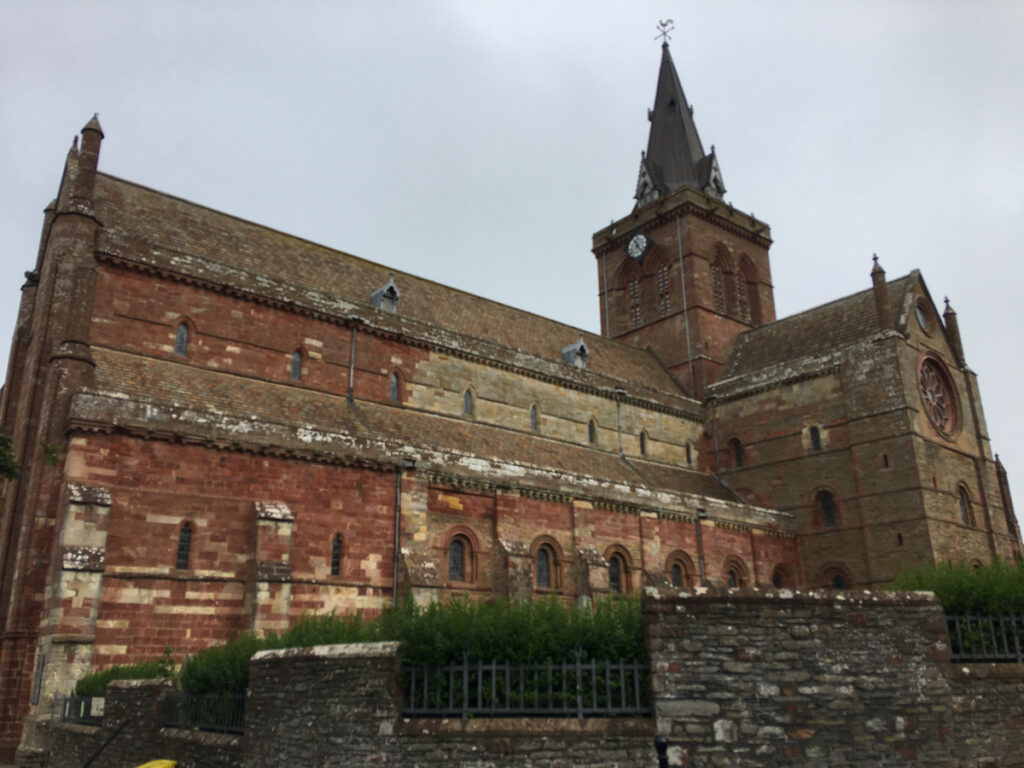
Above: The Cathedral from the south-west; below: the west entrance with the 1621 mercat or market cross (a replica – the original is inside the Cathedral)
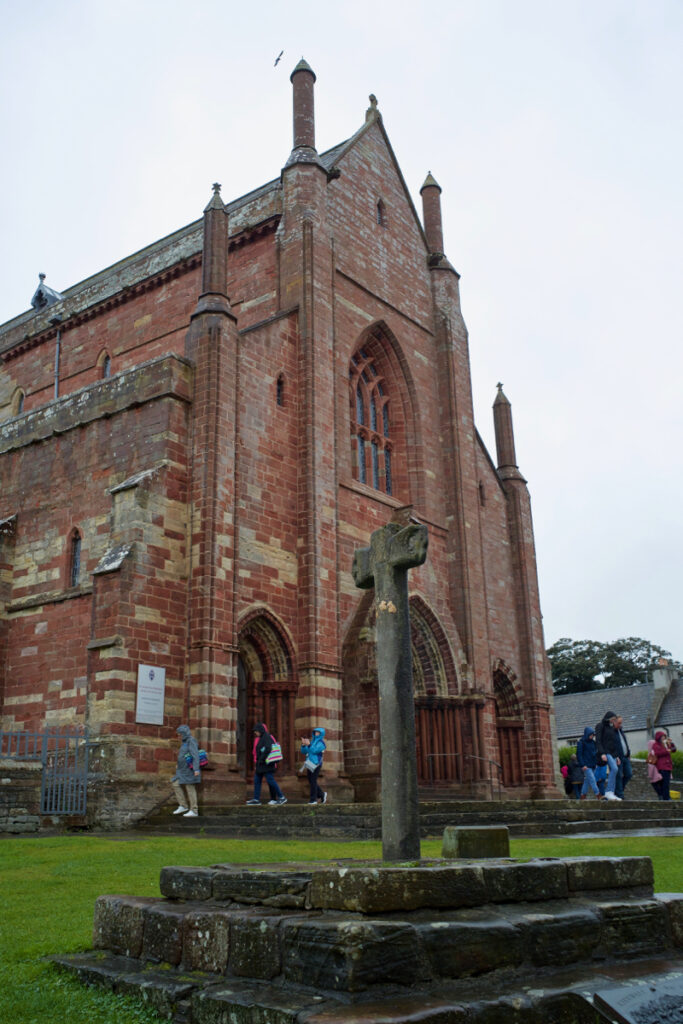
In my previous post about the Brough of Birsay, I mentioned an Orkney earl named Magnus Erlendsson who was murdered by his jealous cousin, Haakon, on the island of Egilsay. As a young man, Magnus seems to have had all the makings of a peace-maker. He sailed with the King of Norway to make a Viking raid on Anglesey, but then refused to take up arms, preferring to stay on the ship and sing psalms instead.
Magnus was given a share in the earldom of Orkney, along with his cousin, Haakon Paulsson. But they had a falling-out, so they agreed to meet on 16th April 1116* on the island of Egilsay in order to negotiate a settlement. The understanding was that each earl would only bring two ships and a limited number of followers, but Haakon turned up with eight ships full of armed men. Too late, Magnus realised that conciliation was never on Haakon’s agenda.
Refusing to allow his own men to defend him, Magnus offered Haakon three options: he would go on a pilgrimage and never return to Orkney; he would be imprisoned for the rest of his life; or he would be maimed and cast into a dungeon. Haakon consulted his followers, and decided that none of those was acceptable. Magnus had to die. But since Haakon’s followers were reluctant to actually murder him, the awful duty was given to Haakon’s cook, Lifolf. As Lifolf took up an axe, Magnus’s last words were said to be: ‘Take heart, poor fellow, and don’t be afraid. I’ve prayed to God to grant you his mercy.’
Magnus’s body was taken to Christ’s Kirk in Birsay, which had been founded by his grandfather, Earl Thorfinn. When a number of miracles were reported there, he was officially declared a saint by the Bishop of Orkney. Meanwhile, Haakon went on pilgrimages to Rome and Jerusalem, presumably to atone for killing his cousin. Eventually the earldom passed to Haakon’s son, Paul, but in 1129 Magnus’s nephew, Kali Kolsson, arrived from Norway and overthrew him. Kali changed his name to Rögnvald, in honour of a previous earl of Orkney, and ordered the construction of a magnificent church in Kirkwall to commemorate St Magnus. Work began in 1137, and in time the relics of St Magnus were enshrined there, as were the remains of Rögnvald (who also became a saint).
There’s nothing half-hearted about these Norsemen, who seem to have gone around with a sword in one hand and a Bible in the other. In many ways, you can sense this strength of will in the cathedral in which they worshipped. It boggles your mind even to realise that they did so, right here, where you are standing.
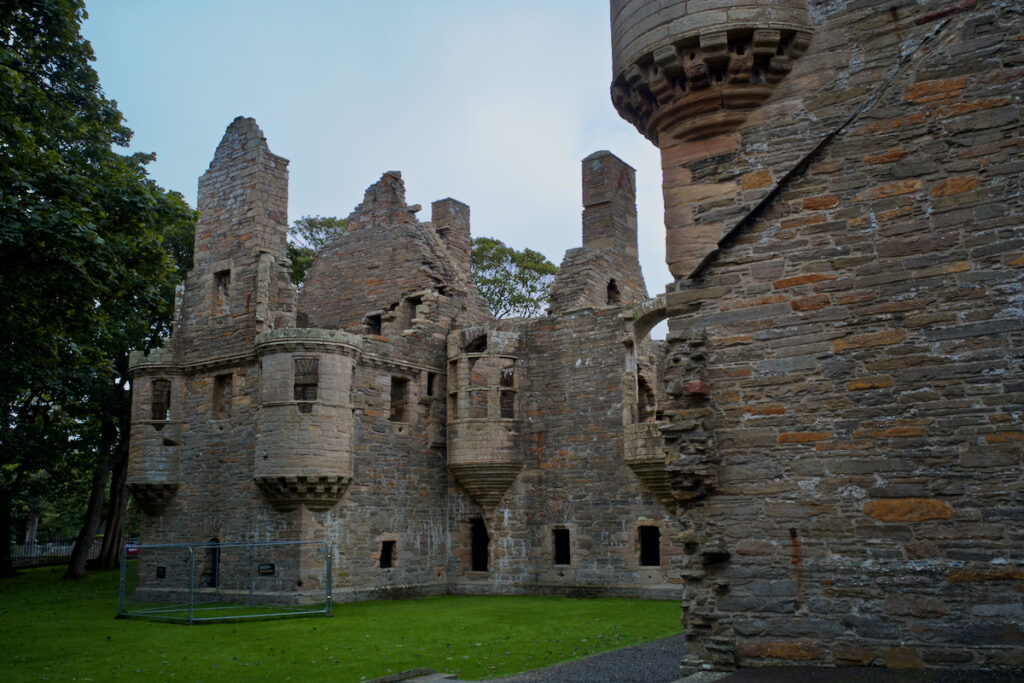
Above & below: Just across the road from the Cathedral, the Bishop’s Palace was built as a dwelling for Bishop William the Old (1102 or 1112-1168), one of St Magnus’ first bishops. When tales of miracles began to arise around Magnus’ grave in Birsay, William initially dismissed them as heresy. However, he subsequently experienced two miracles attributed to Magnus: firstly, while storm-bound in Shetland, he prayed for calm weather and in return he vowed to support the transfer of Magnus’ relics to Kirkwall. The weather improved, and he was able to sail to Orkney in time for mass. On the second occasion, Bishop William was struck with sudden blindness, and prayed for healing at Magnus’ grave. His sight was soon restored, and thereafter he supported the elevation of Magnus to sainthood.
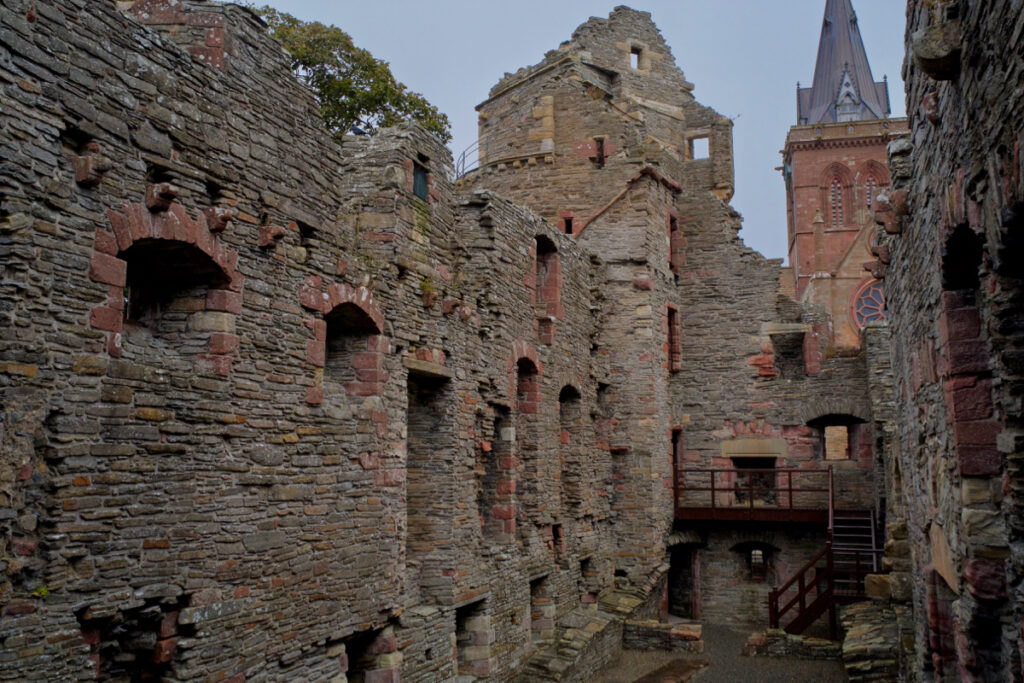
St Magnus’ bones were re-discovered in 1919: they had been placed in a wooden box and sealed into one of the massive square pillars that stand either side of the choir. It was said that the skull, when examined, bore a cut that was consistent with an axe blow to the head. The box is now in the Orkney Museum, just across the road, but the bones were returned to their original location.
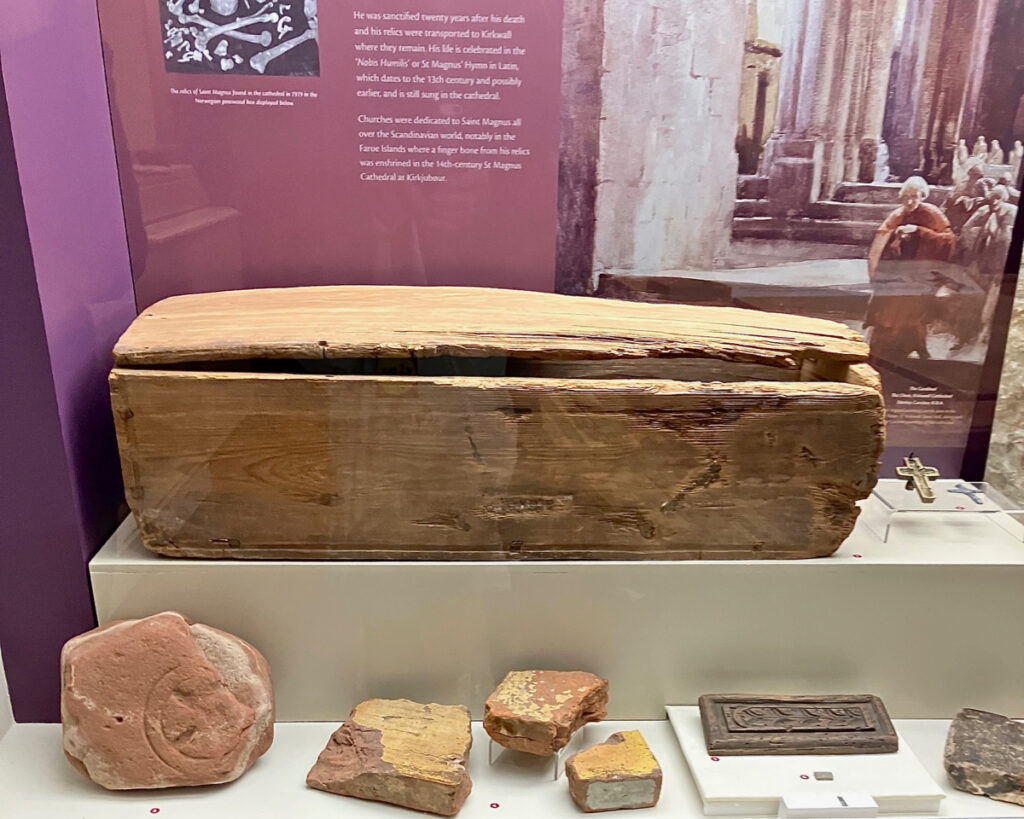
The original box that contained St Magnus’ relics, now in the Orkney Museum
So much about this building is remarkable. Two colours of sandstone – red from Head of Holland, north of Kirkwall, and yellow, most likely quarried on the island of Eday – have been used to great effect both inside and out. The stonemasons, it is believed, had been trained at Durham Cathedral. Along the nave, a series of blind Romanesque-style arches alleviate the weight of the walls and add to the sense of soaring space. And those immense pillars, upholding it all, put you in mind of Valhalla.
‘Earl Rögnvald… supervised the earliest stages of the building in 1137 during the bishopric of William the Old of Orkney (1102-68)… The walls, ceilings and pillars would have originally been plastered and painted with colourful floral patterns.’ (St Magnus’ Cathedral guidebook).
Along the walls of the nave aisles, some old tombstones dating from the 17th century commemorate notable people of Orkney. A square wooden memorial known as a ‘mort brod’ hangs from a pillar, painted with a rather macabre skeleton as a memento mori or reminder of death. It is said to commemorate a glazier named Robert Nicholson. On an elaborate stone memorial, Elizabeth Cuthbert, the wife of a Cathedral minister, is shown kneeling in prayer with her long hair flowing down her back. In the choir, a life-size sculpture depicts the Arctic explorer John Rae sleeping peacefully amid a pile of furs with his gun at his side. And in a shallow recess, two British flags draped above a ship’s bell pay tribute to 833 men who died in 1939 when HMS Royal Oak was torpedoed in Scapa Flow by a German U-boat.
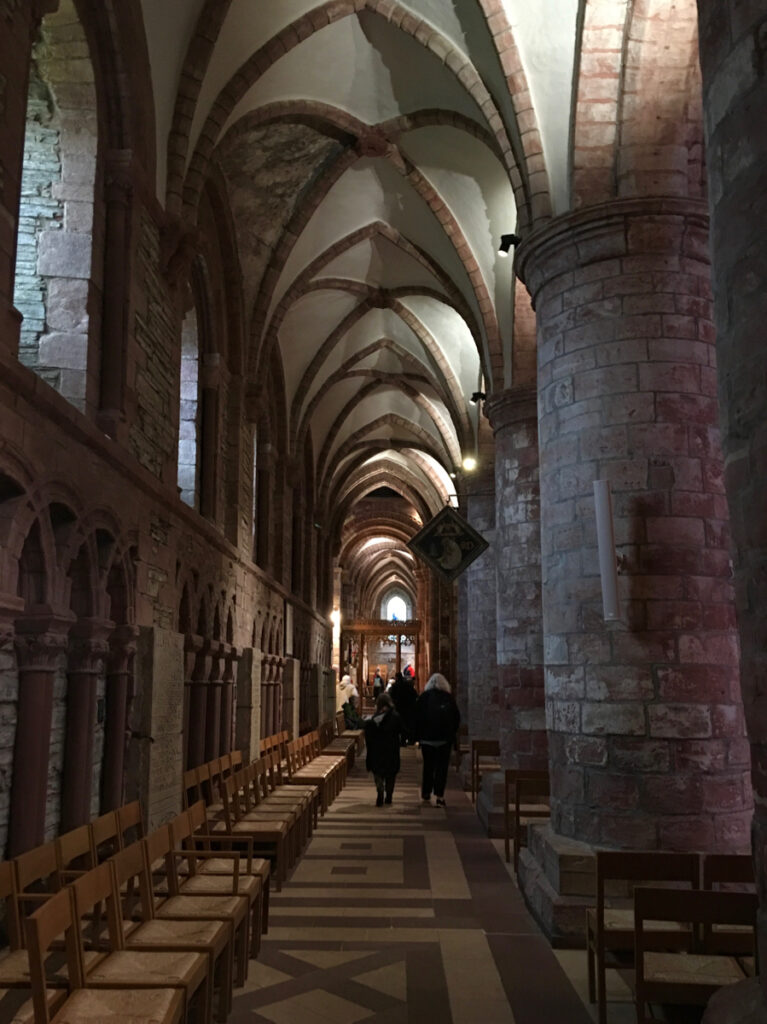
Above: the north aisle, with (below) the Mort Brod
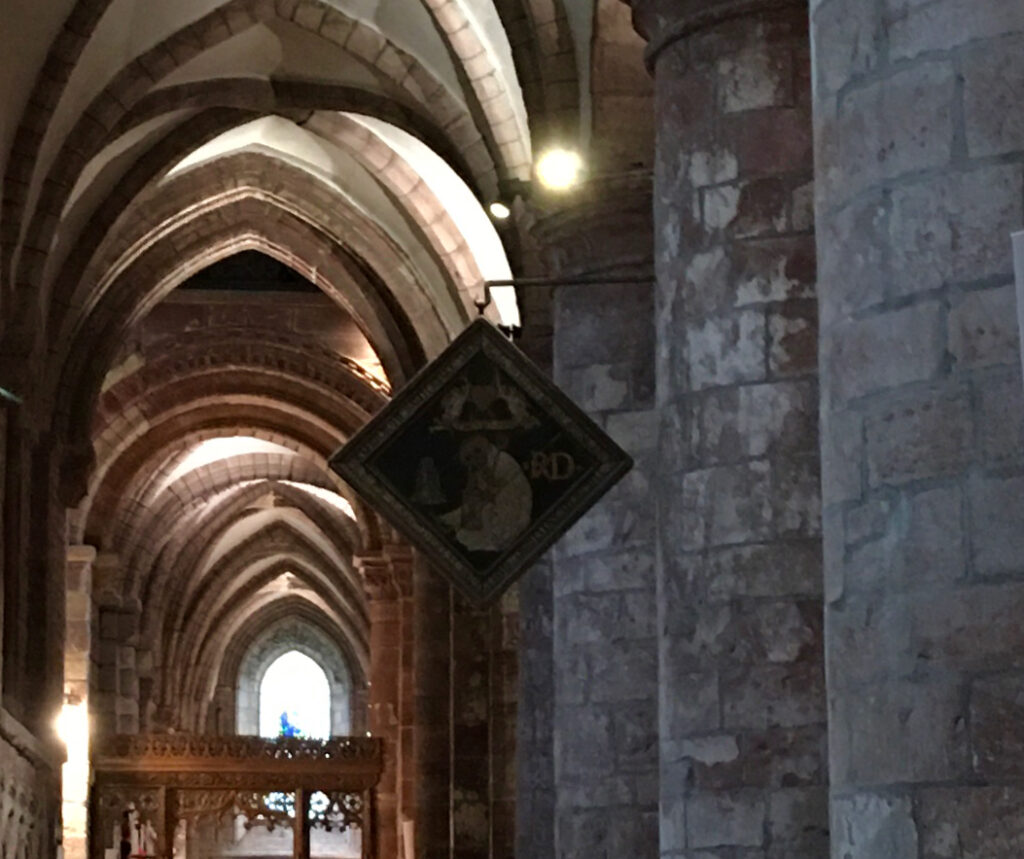
There are carved figures of bishops, saints, and a Norse warrior in a winged helmet, resting his hands on his sword hilt. Stained glass windows by 20th century designers Oscar Patterson, Douglas Strachan and Crear McCartney punctuate the shadows with jewel-like colours. According to the guidebook, the Cathedral’s bells date from 1528; the largest was re-cast after a lightning strike in 1671 set fire to the original wooden steeple and the bells crashed to the floor.
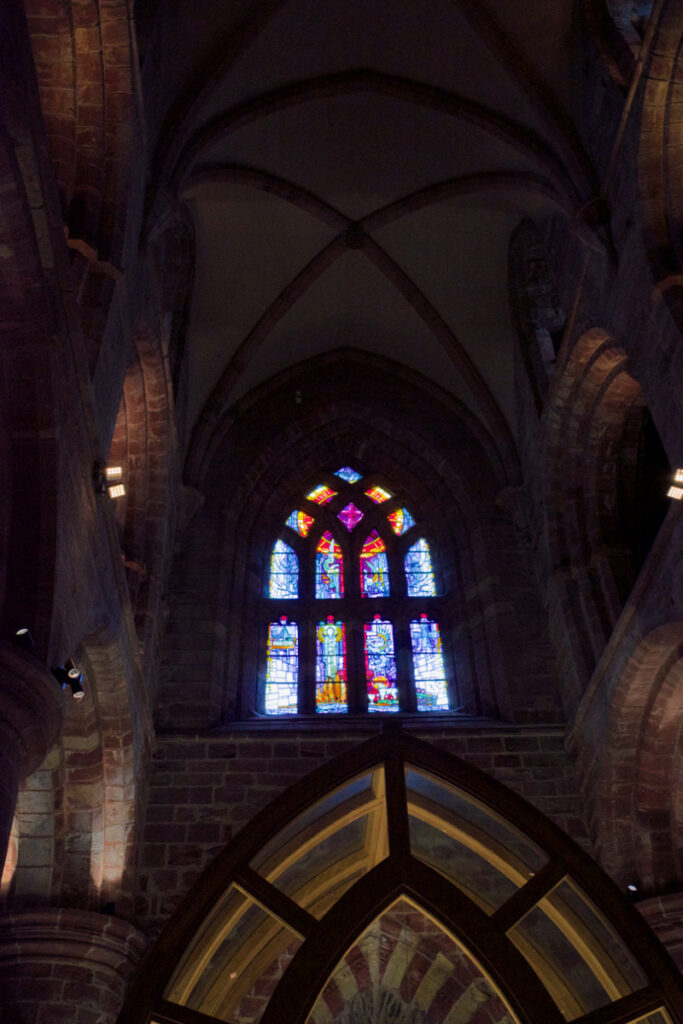
The west window, designed by Crear McCartney and unveiled by Queen Elizabeth II in 1987
In 1472, some 335 years after the Cathedral was founded, Norse control of the Earldom of Orkney came to an end. The King of Norway, Christian I, had pledged both Shetland and Orkney as security for the dowry of his daughter Margaret, who was betrothed to James III of Scotland. But the dowry was never paid, and James III annexed Shetland and Orkney to the Scottish crown on 20th February 1472. Later that year, when Pope Sixtus IV created an archbishopric based in St Andrews, he attached to it the bishopric of Orkney.
There is so much to see in the Cathedral that you really need to make several visits. For instance, a little leaflet that you can pick up inside the door is devoted entirely to graffiti, carvings and inscriptions, of which there are over 600 on the ground floor alone. Relics and artefacts, both ancient and modern, demand attention: a font inlaid with polished stones from each island and parish in Orkney celebrates the Cathedral’s 850th anniversary, and a tapestry donated by Hordaland Council in Norway marks the same event. Business-like iron rings, hammered into the pillars, are reminders of Cromwell’s occupation during the Civil War in the mid-1600s, when his soldiers seized the Cathedral for their barracks. The rings were used to tether horses.
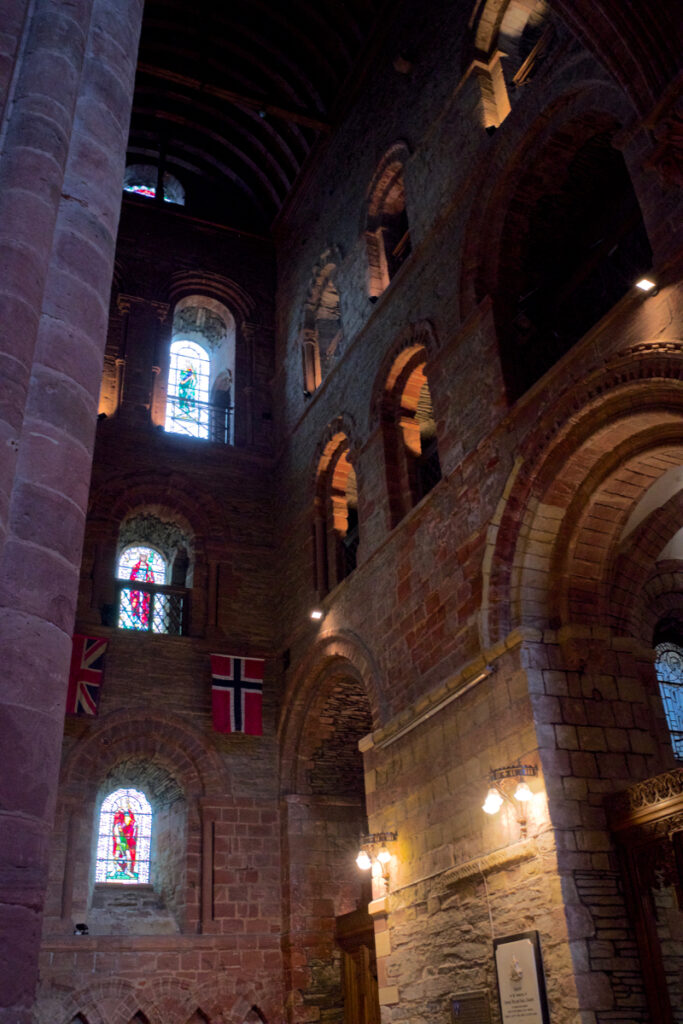
The north transept
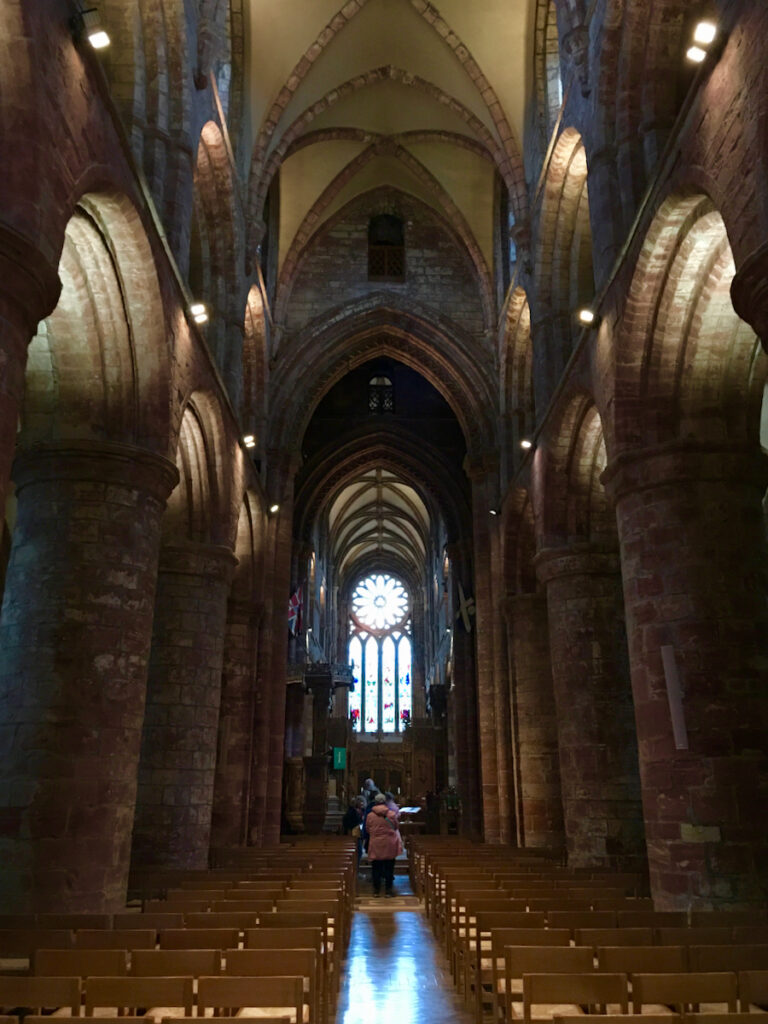
Above & below: Looking up the nave towards the east window
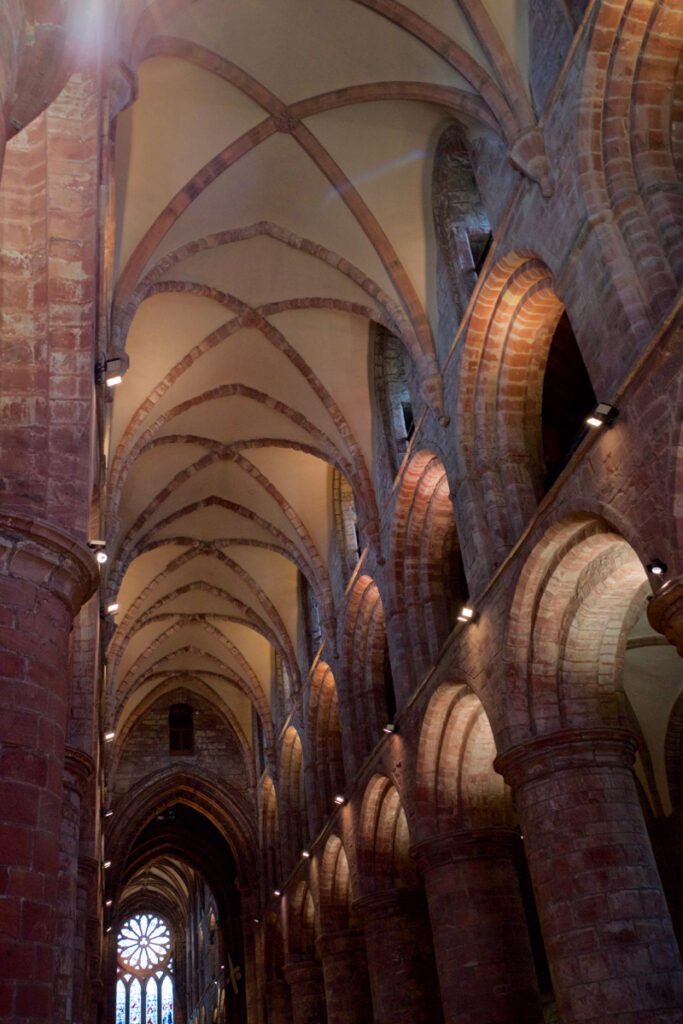
Apparently, St Magnus’ is the only Cathedral in Britain to have its own dungeon. More bloodthirsty Norsemen, you might think, but it seems to have been created in the 16th century. Named ‘Marwick’s Hole’, for a reason that is now lost, it was in use until the 1700s. Writing in 1900, B H Hossack explains that on the triforium level, a slit-like opening gave way to a chute through which convicted prisoners were ejected into a dark chamber below. He adds: ’The clerical tribunal sat in the upper room, so when an unfortunate offender was sentenced to imprisonment he glided gently from the hall of justice directly into his cell… Many a time has the Cathedral echoed with the screams and imprecations of reluctant women and men on their way, short as it was, to the dreaded “Marwick’s Hole.”’
The website orkneyjar.com adds that in 1629, an Orkney woman named Janet Forsyth, who was accused of witchcraft and sentenced to be burnt at the stake, was rescued from Marwick’s Hole by her lover. Janet seems to have suffered a great deal of abuse for acts that, these days, would be described as heroic.
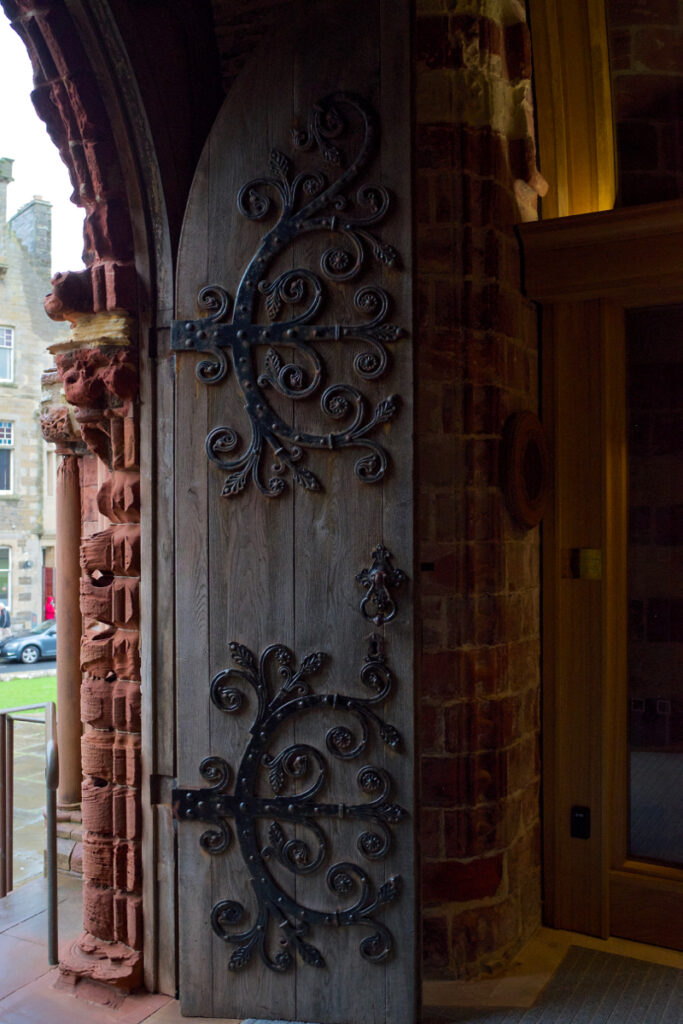
The west door (above) and views of Kirkwall town centre (below)
The things that I’ll remember from St Magnus’ Cathedral are its presence and power, guarding a palpable sense of inner sanctuary. It’s spectacular but not pretentious. More than that, there’s something quite magnetic about this beautiful building; the warm colour and pleasing proportions, perhaps, if you want to be pragmatic, but I feel as if there’s something deeper that is still actively radiating the convictions and courage of its Norse founders, and preserving the simple devotion of the saints whose bones rest within it. If Earl Rögnvald could be described as having made a witness statement, this is surely it.
*Some sources say Magnus was murdered in 1117
Reference:
- St Magnus’ Cathedral website
- Official Cathedral guidebook
- Orkneyjar
- The Orkney News
- B H Hossack, Kirkwall in the Orkneys (1900)
- Historic Environment Scotland: Bishop’s Palace, Kirkwall
Images copyright © Colin & Jo Woolf



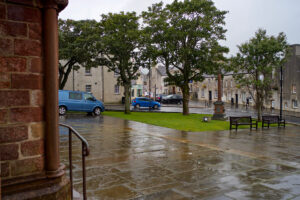
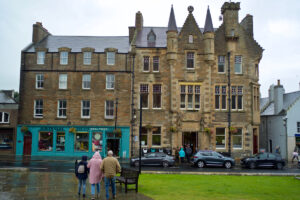
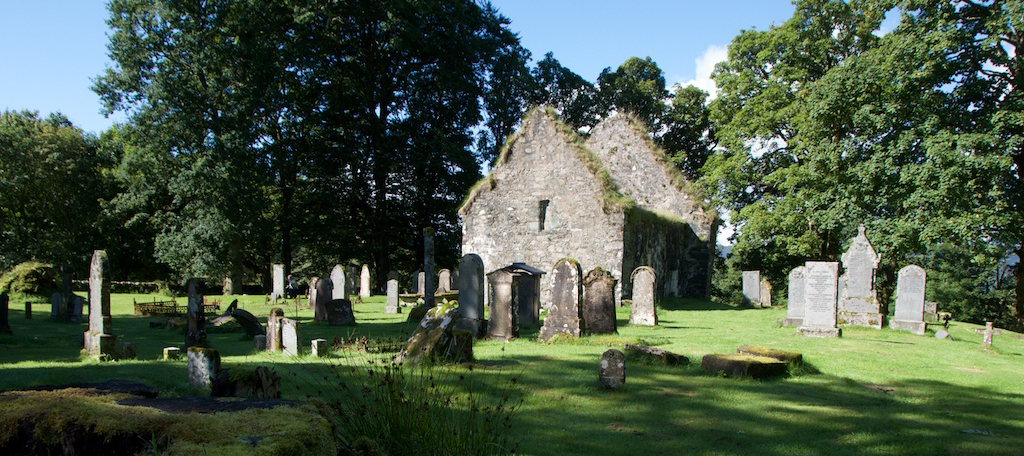
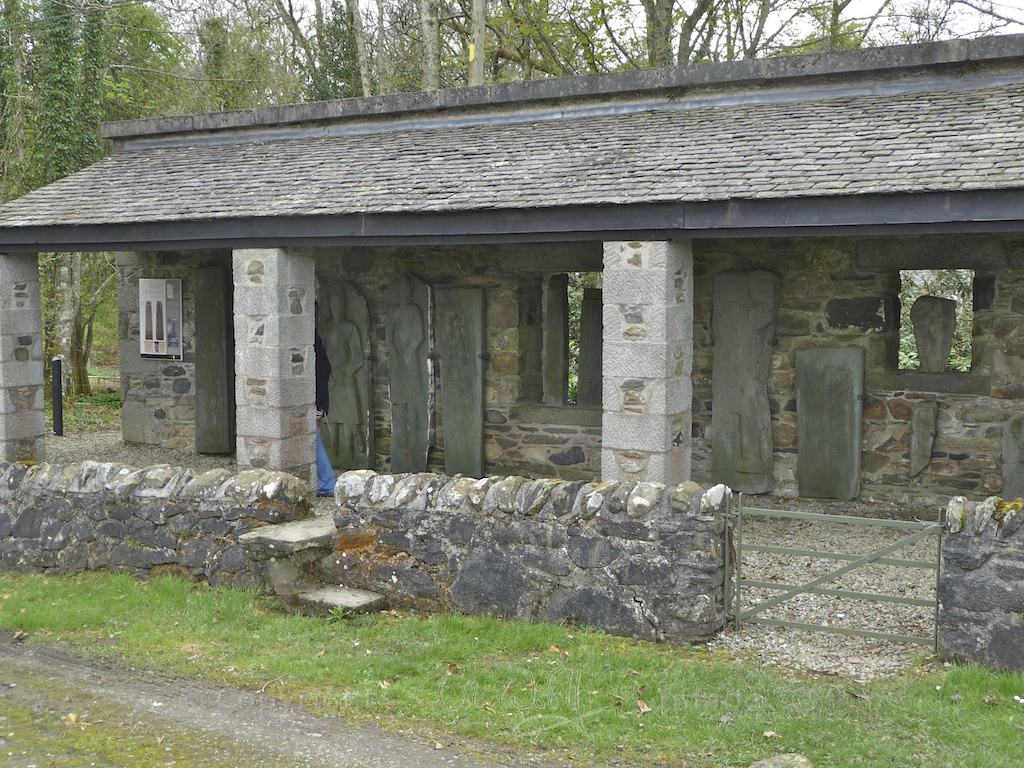
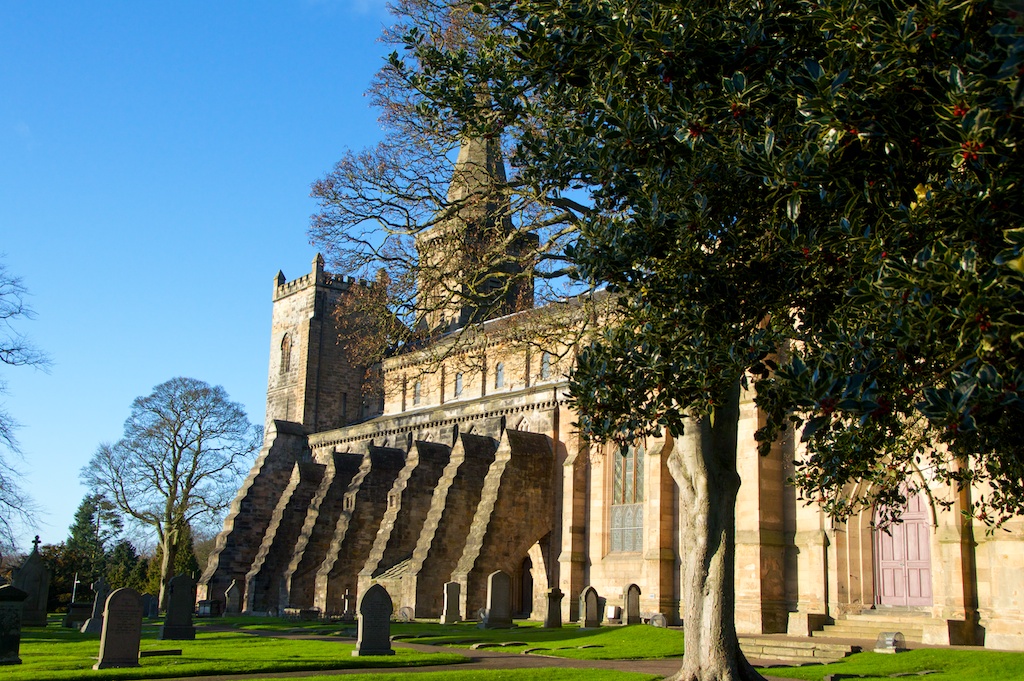
10 Comments
davidoakesimages
Great minds think alike….. here is a link to my Sunday blog… https://davidoakes-images.com/2023/11/26/silent-sunday-off-to-church-40/ 🙂
Jo Woolf
Oh what gorgeous images, David! Thank you for sharing that. Can’t believe you made a post about it too!
Finola Finlay
Makes me want to fly to Orkney NOW. I’m m ashamed of how unfamiliar I am with those Viking saints. This was a good intro.
Jo Woolf
I didn’t know much about Orkney’s history and saints either. It seems such a world away from Argyll!
Susan Abernethy
Like you Jo, I’ve always wanted to visit this cathedral. Sounds like an amazing experience. Someday I will see it!
Jo Woolf
I do hope you get there, Susan! There are so many places in Orkney you’d absolutely love!
Bob Hay
Fascinating article Jo and such an intriguing building. Bolsters the relatively unappreciated importance of Orkney in the Scandinavian /Scottish medieveal world. I’m glad to read that humble but highlyskilled stonemsons from Durham were recognised as involved in its construction. Usually these impresive building are recorded as ‘Built by King or Earl so and so’.
Jo Woolf
Thank you, Bob! I think the Cathedral still symbolises the importance of Orkney at that time. And it took about 300 years to build, which is a timespan that these days would be unthinkable.
Bob Hay.
That’s not an unusual time for waiting for your house to be built in Australia😁
Jo Woolf
😂😂